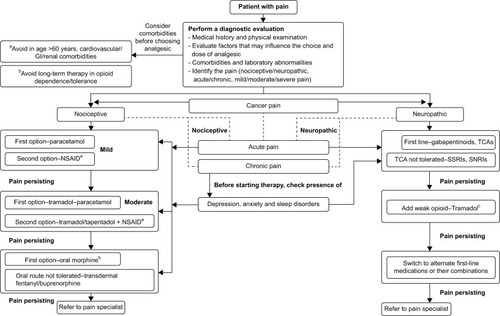Figures & data
Table 1 Different types of pain
Figure 1 Mechanism of peripheral versus central sensitization.
Abbreviations: AMPA, α-amino-3-hydroxy-5-methyl-4-isoxazolepropionic acid receptor; ATP, adenosine triphosphate; ASIC, acid-sensing ion channels; BDNF, brain-derived neurotropic factor; 5-HT, 5-hydroxytryptamine; IL, interleukin; NMDA, N-methyl-d-aspartate receptor; NGF, nerve growth factor; PG, prostaglandin; NK1, neurokinin-1; TNF, tumor necrosis factor; TrkB, tyrosine receptor kinase B; TRPV, transient receptor potential vanilloid receptor.

Figure 2 Therapeutic modulation of the pain-processing pathway.

Table 2 Available therapies for treatment of pain
Table 3 Different pain assessment scales for measuring the intensity of pain
Figure 3 Pain algorithm.
Abbreviations: GI, gastrointestinal; NP, neuropathic pain; NSAID, nonsteroidal anti-inflammatory drug; SNRI, serotonin–norepinephrine reuptake inhibitor; SSRI, selective serotonin reuptake inhibitor; TCA, tricyclic antidepressant.

Table S1 Treatment recommendations
